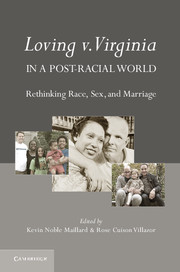Book contents
- Frontmatter
- Contents
- About the Contributors
- Acknowledgments
- Foreword
- Introduction Loving v. Virginia in a Post-Racial World
- Part One Explaining Loving v. Virginia
- Part Two Historical Antecedents to Loving
- 2 Telling Stories of Love, Sex, and Race
- 3 Loving in Indian Territory
- 4 American Mestizo
- 5 Perez v. Sharp and the Limits of Loving
- Part Three Loving and Interracial Relationships: Contemporary Challenges
- Part Four Considering the Limits of Loving
- Part Five Loving Outside the U.S. Borders
- Part Six Loving and Beyond: Marriage, Intimacy, and Diverse Relationships
- Permission Granted
- Index
- References
3 - Loving in Indian Territory
Tribal Miscegenation Law in Historical Perspective
Published online by Cambridge University Press: 05 July 2012
- Frontmatter
- Contents
- About the Contributors
- Acknowledgments
- Foreword
- Introduction Loving v. Virginia in a Post-Racial World
- Part One Explaining Loving v. Virginia
- Part Two Historical Antecedents to Loving
- 2 Telling Stories of Love, Sex, and Race
- 3 Loving in Indian Territory
- 4 American Mestizo
- 5 Perez v. Sharp and the Limits of Loving
- Part Three Loving and Interracial Relationships: Contemporary Challenges
- Part Four Considering the Limits of Loving
- Part Five Loving Outside the U.S. Borders
- Part Six Loving and Beyond: Marriage, Intimacy, and Diverse Relationships
- Permission Granted
- Index
- References
Summary
State antimiscegenation laws aimed to regulate white desire for black bodies in an effort to preserve white racial purity and ultimately white supremacy. Facially, these laws did not regulate intimate relations when such relations involved only people of color. For example, state statutes typically did not preclude a Native-American person from marrying an African-American person. But a careful examination of the social and legal atmosphere that was created by state antimiscegenation laws reveals that these state laws did impact the desire of nonwhite people of color to marry black persons.
State miscegenation laws that ultimately permitted whites to marry Indians aided the assimilation of Indians into mainstream white America by operating as a form of racial rehabilitation. Indian assimilation, however, required more than Indians intermarrying with whites; it required the total indoctrination of Indians into the system of white supremacy. This meant that Indians needed to adopt white sexual mores, including the aversion to race mixing with blacks.
During the antebellum period, four of the tribes referred to by the federal government as the “Five Civilized Tribes” adopted miscegenation laws that attempted to preclude Indians from marrying or having sexual relations with blacks. Through the regulation of Indian-black sexual relations, the tribes sought to avoid mixed-race offspring and thereby protect Indian identity from “corruption.” Indians viewed themselves as a free and self-governing people, which was the basis for claiming tribal sovereignty. This view of self was in contradistinction to blacks who generally were not free, but bonded and without rights that the white man was bound to respect.
- Type
- Chapter
- Information
- Loving v. Virginia in a Post-Racial WorldRethinking Race, Sex, and Marriage, pp. 46 - 58Publisher: Cambridge University PressPrint publication year: 2012



